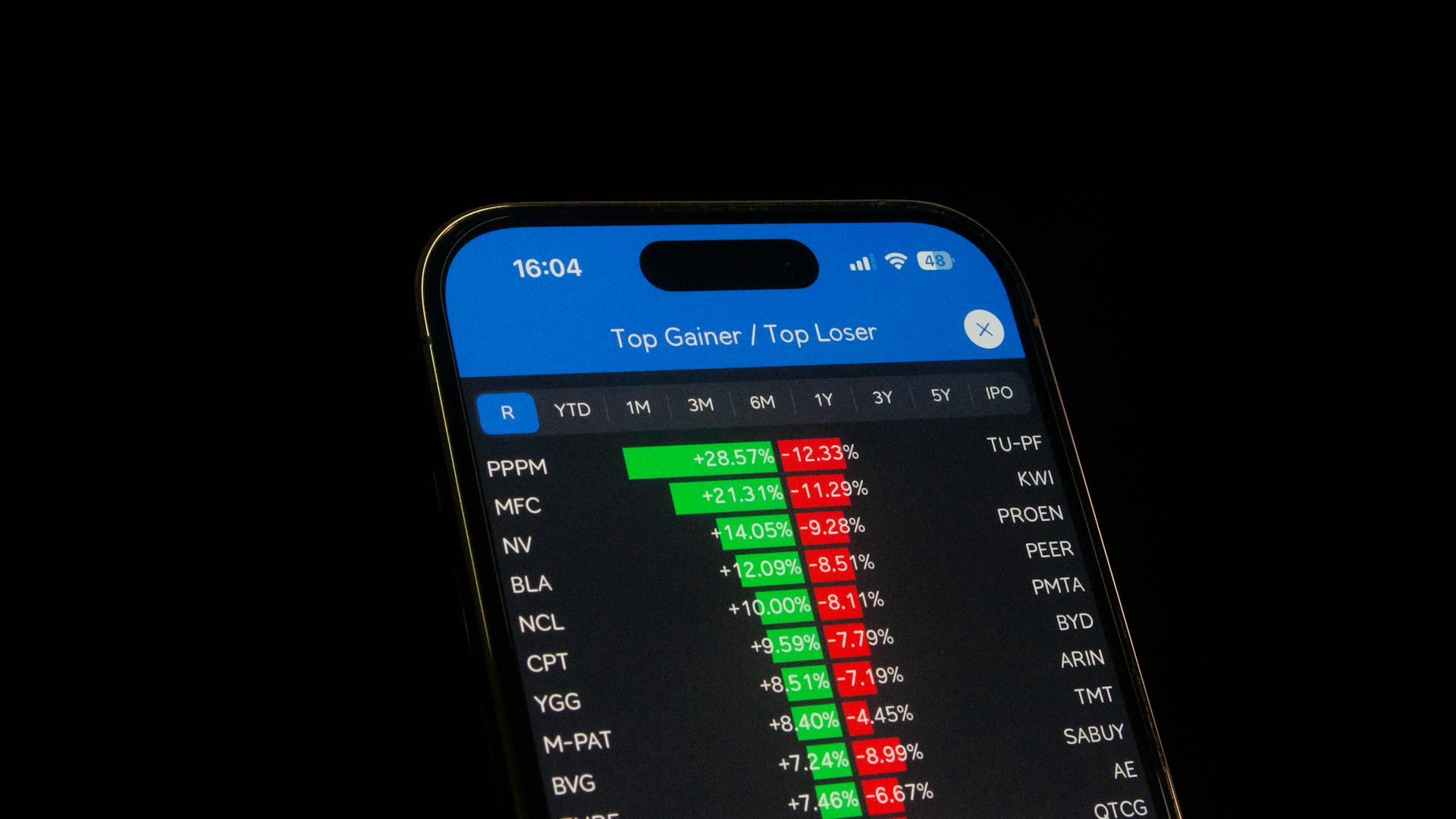
Margin of safety is a crucial concept in value investing, and Seth Klarman's approach to it is particularly noteworthy. He defines it as the difference between the intrinsic value of a business and its market price.
This margin of safety serves as a buffer against potential losses, allowing investors to make informed decisions without putting their entire portfolio at risk.
By maintaining a margin of safety, investors can avoid overpaying for a business and instead focus on acquiring undervalued assets. Seth Klarman emphasizes the importance of this buffer in his book "Margin of Safety".
Origin and Definition
The concept of margin of safety originates from engineering, where prudent engineers intentionally over-design structures to account for unanticipated loads and potential stresses.
This "cushion" or margin of safety allows structures to accommodate greater pressures than expected, providing a crucial safeguard against errors in calculations or unexpected events.
Benjamin Graham, a great investor, adapted this principle to stock investing and value analysis. He defined margin of safety as the difference between a stock's purchase price and its estimated intrinsic or true underlying business value.
The greater the chasm between the price paid by the investor and the calculated worth of the asset, the larger the built-in margin of safety. This valuation gap provides crucial protection against errors in analysis or unforeseen declines in corporate value.
Explore further: The Dhandho Investor the Low-risk Value Method to High Returns
Klarman's Approach
Klarman's approach to margin of safety is a deeply conservative value philosophy that targets extremely undervalued opportunities with enormous downside protection and long-term upside potential.
He performs exhaustive analysis to arrive at a conservative estimate of intrinsic value, then aims to invest at a substantial discount to even his most cautious calculated appraisals.
Klarman demands a margin of safety of 50% or more to a business' intrinsic value estimate, which is significantly wider than what most prudent value investors consider.
By insisting on such a considerable margin of safety, Klarman secures two key benefits for his investors: tremendous resilience against permanent loss and dramatic upside potential over the long run.
His portfolio gains plenty of room for unforeseen financial, economic, or industry developments, making it more resilient to potential losses.
The large valuation gap between Klarman's estimates and the actual business value ultimately closes as fundamentally sound companies increase their business value over time.
Related reading: Scion S Capital Meaning Michael Burry
Benefits and Reception
Klarman's approach to investing has secured two key benefits for his investors: tremendous resilience against permanent loss and dramatic upside potential over the long run.
A considerable margin of safety provides downside protection, minimizing potential losses even in cases where actual business value deteriorates. This is a crucial aspect of Klarman's approach.
Incorporating a sizable margin of safety into one's investing approach provides several profound benefits, including room for error, capitalizing on volatility, imposing rationality, true risk management, and maximizing rewards.
Here are the specific benefits of incorporating a margin of safety:
- Downside protection: minimizes potential losses
- Room for error: allows breathing room in case of mistakes
- Capitalizing on volatility: enables taking advantage of irrational price declines
- Imposes rationality: prevents reaction to ephemeral market noise
- True risk management: emphasizes prudent valuation
- Maximizing rewards: substantial upside potential when valuation difference closes
The book "Margin of Safety" has achieved "cultlike" status amongst the value investing community, with physical copies selling for up to $2,500 and resulting in piracy of the book.
A unique perspective: The Little Book That Still Beats the Market Joel Greenblatt
Klarman's Approach Benefits
Klarman's approach benefits are numerous and well-documented. By insisting on a considerable margin of safety, Klarman secures two key benefits for his investors: tremendous resilience against permanent loss and dramatic upside potential over the long run.
His portfolio gains tremendous resilience against permanent loss, with plenty of room for unforeseen financial, economic or industry developments. This is because a large margin of safety serves to minimize potential losses, even in cases where actual business value deteriorates and turns out substantially lower than original estimates.
A margin of safety allows crucial breathing room in case of mistakes in analysis or overly optimistic financial projections and assumptions. This is one of the profound benefits of incorporating a sufficient margin of safety into one's investing approach.
Here are some of the key benefits of Klarman's approach:
- Downside protection: A large margin of safety minimizes potential losses.
- Room for error: A margin of safety allows breathing room in case of mistakes.
- Capitalizing on volatility: A valuation cushion enables taking advantage of irrational price declines.
- Imposes rationality: A margin of safety instills discipline, patience, objectivity and rationality.
- True risk management: A margin of safety manages risk through an emphasis on prudent valuation.
- Maximizing rewards: The upside potential is substantial when the valuation difference eventually closes.
Klarman's approach to margin of safety is deeply conservative, targeting extremely undervalued, out-of-favor opportunities that appear likely to provide enormous downside protection.
Reception and Impact
The book has achieved a cultlike status amongst the value investing community, being revered as a "bible" of sorts.
It's been featured in a number of recommended reading lists in the investment press, a testament to its enduring popularity and influence.
Physical copies of the book have become highly valuable, with prices ranging from $500 to $2,500 a piece.
Expand your knowledge: Value Investing Book
Investment Strategies
Seth Klarman's value investing approach is centered around a "bottom-up strategy" that involves identifying specific undervalued investment opportunities.
He's not interested in beating the market, but rather in achieving absolute returns by investing in companies with a significant margin of safety.
Klarman's discipline has paid off, with Berkshire Hathaway's per-share market value increasing at a 20.1% annual rate since he took control in 1965, compared to a 9.7% return for the S&P 500 Index over the same period.
See what others are reading: How Did Michael Burry Short the Housing Market
Bottom-Up Investing
Value investing is a bottom-up strategy that focuses on identifying specific undervalued investment opportunities. This approach involves looking at individual companies and their intrinsic value, rather than comparing them to a benchmark or market average.
Seth Klarman emphasizes the importance of a risk-averse approach in value investing, where attention is paid as much to what can go wrong as to what can go right. This means considering the potential risks and pitfalls of an investment, not just its potential returns.
Suggestion: Ray Dalio Economic and Investment Principles
Net-net working capital is a technique used to approximate a company's liquidation value, and it's a conservative approach that can provide protection for investors. This method involves subtracting long-term liabilities from net working capital, which includes current assets minus current liabilities.
Investors who buy a company at a price below its net-net working capital are protected by the approximate liquidation value of its current assets alone. However, ongoing business losses can quickly erode net-net working capital, so investors must consider a company's current operations before making a purchase.
Liquidation value is considered the most useful method because it's the most conservative approach. This is because it takes into account the potential risks and pitfalls of an investment, providing a more accurate picture of a company's true value.
Here's an interesting read: Bill Ackman Hedge Fund
Investing
Investing is a mindset, not just a strategy. Seth Klarman, a renowned value investor, follows the principles of Benjamin Graham, emphasizing the importance of a substantial margin of safety when acquiring stocks.
This margin of safety provides a considerable cushion against loss in case of analytical errors or business underperformance. By being deeply contrarian and only buying at bargain valuations, Klarman exhibits remarkable discipline and rationality.
Value investing is a risk-averse approach, paying attention as much to what can go wrong (risk) as to what can go right (return). Klarman believes that risk is primarily the possibility of paying too high a price rather than stock price volatility.
Investors should focus on identifying specific undervalued investment opportunities, rather than trying to beat the market. A bottom-up strategy involves analyzing individual companies, rather than relying on broad market trends.
To value a stock effectively, investors can use three methods: Liquidation or Breakup Value, Stock Market Value, and Discounted Cashflow Analysis (DCF). Each method has its pros and cons, and investors should use multiple methods to get a range of valuation figures.
Here are the three valuation methods proposed by Klarman:
- NPV (or DCF - Discounted Cash Flows): the discounted value of all future cash flows that a business is expected to generate.
- Liquidation Value: the expected proceeds if a company were to be dismantled and the assets sold off.
- Stock Market Value: an estimate of the price at which a company, or its subsidiaries considered separately, would trade in the stock market.
Warren Buffett, a successful value investor and Graham's mentee, also emphasizes the importance of a margin of safety. He seeks to buy at prices low enough to provide confidence in an acceptable return even if the business falls on hard times.
Buffett's discipline has paid enormous dividends, with Berkshire Hathaway's per-share market value increasing at a 20.1% annual rate compared to a 9.7% return for the S&P 500 Index over the same period.
You might enjoy: Warren Buffett Value Investing
Investment Risk
Investment risk is often misunderstood as being synonymous with stock price volatility. However, according to Seth Klarman, risk should be understood as the "risk of loss", which is derived from deteriorating business fundamentals.
Klarman argues that risk and return are not always correlated, and that the risk of an investment is described by both the probability and the potential amount of loss. He emphasizes that no more is known about the risk of an investment after it is concluded than was known when it was made.
Traditional risk metrics, such as beta, are limited because they are backward-looking and based on the efficient market hypothesis. This means they have little predicting power and assume all information is already incorporated into market prices.
Warren Buffett, a successful value investor, also views risk as the possibility of paying too high a price rather than stock price volatility. He consistently acquires stocks and companies at prices appreciably below his conservative appraisals, which has paid enormous dividends.
If this caught your attention, see: Bill Ackman Stock
Klarman and Buffett both emphasize the importance of investing with a margin of safety to minimize the risk of loss. This involves diversifying holdings, hedging when possible, and investing with the largest possible margin of safety.
Value investors like Klarman and Buffett believe that risk should be understood as the risk of loss, rather than stock price volatility. They focus on the potential for loss and aim to acquire securities at prices that provide a meaningful margin of safety.
By understanding risk in this way, value investors can make more informed decisions and avoid investing in overpriced, ill-conceived, or poorly managed investments. This approach has been successful for Klarman and Buffett, and can be a valuable lesson for investors of all levels.
Here's an interesting read: Value Investing from Graham to Buffett and beyond
Key Ideas and Philosophy
Value investing is a bottom-up strategy that involves identifying specific undervalued investment opportunities, as Seth Klarman emphasizes in his book. This approach focuses on finding companies with a significant margin of safety, which is the difference between the company's intrinsic value and its market price.
The margin of safety is crucial in value investing because it provides a buffer against losses. According to Warren Buffett, the first rule of investing is "don't lose money", and the second rule is "never forget the first rule." This means that investors should prioritize minimizing losses over maximizing profits.
Investors can achieve a margin of safety by buying stocks at a discount to their intrinsic value. The larger the discount, the smaller the risk of losing money. Klarman stresses that investors should focus on minimizing losses first and then maximizing profits second.
Risk is not just about stock price volatility, but also about the possibility of paying too high a price. Klarman and Buffett both see risk as the probability and amount of loss due to permanent value impairments. This means that investors should prioritize finding undervalued companies with a significant margin of safety.
Valuation is an art, not a science, and it's imprecise. Investors should look for a range of values to arrive at a big margin of safety. They should also use a variety of methods to estimate value, including considering tangible assets and intangible assets with caution.
Investors should know the limitations of each valuation method and be cautious of NPVs, which are precise but of limited use. They should also be wary of earnings, which should be taken with a grain of salt, and book value, which can be more reliable but still has its limitations.
The margin of safety is a fundamental concept for long-term value investors, and it's not just a strategy, but a mindset. By being deeply contrarian and only buying at bargain valuations, investors can minimize risk and maximize reward through the consistent use of a margin of safety.
On a similar theme: Gabe Plotkin Dumb Money
Frequently Asked Questions
How did Seth Klarman make his money?
Seth Klarman made his money through his successful hedge fund, which has generated annual returns of 20% for over three decades through value investing in discounted stocks, particularly in tech and telecom sectors. His investment strategy has yielded impressive results over the years.
What stocks is Seth Klarman buying?
Seth Klarman's current top stock holdings include Liberty Global, Willis Towers Watson, Clarivate, Alphabet, and CRH, as of 2024-09-30. These holdings may not reflect his entire portfolio, but provide insight into his current investment strategy.
Sources
- https://www.gurufocus.com/news/2086525/why-seth-klarman-swears-by-the-margin-of-safety
- https://en.wikipedia.org/wiki/Margin_of_Safety_(book)
- https://www.theinvestorspodcast.com/episodes/classic-seth-klarmans-book-margin-of-safety/
- https://substack.kikohimself.com/p/my-notes-on-seth-klarmans-margin-db8
- https://www.chaindesk.ai/tools/youtube-summarizer/margin-of-safety-summary-by-seth-klarman-D8TYIYHwiY0
Featured Images: pexels.com


